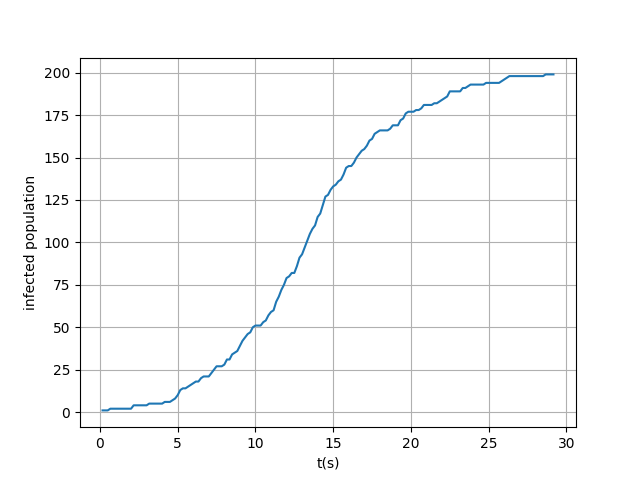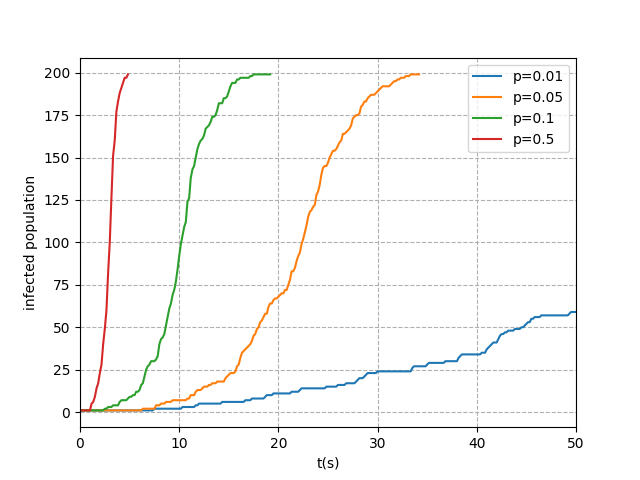감염 시뮬레이션 - pygame
개요
감염 시뮬레이션 기본편 processing 코드를 pygame으로 다시 작성
pygame은 vsc에서 구동 가능하여 여러 라이브러리들을 같이 쓸 수 있음
솔직히 processing은 필수적인 라이브러리가 안돼서 불편했다
특히 numpy가 안됐던 것이 너무나도 불편해서 그냥 앞으로 쭉 pygame 쓰는게 낫겠다고 생각함
특히 그래프 그릴 때 matplotlib랑 같이 쓸 수 있어서 더 정확한 그래프 그리기가 가능함
결과
matplotlib로 작성한 결과그래프는 다음과 같다.
감염률 다르게 총 네 번 시행하였고
전체적인 그래프의 모양은 동일하지만 감염률에 따라 그래프 폭이 달라진다는 것을 확인할 수 있다.

-> p = 0.05로 한번 시행했을 때의 그래프

소스코드
import time
import pygame as pg
from math import dist
from random import *
import numpy as np
from infection_graph import graph
c_size_x = 600
c_size_y = 600
def timeshow():
return time.time()
pg.init()
screen = pg.display.set_mode([c_size_x,c_size_y])
title = 'infection_simulation'
pg.display.set_caption(title)
clock = pg.time.Clock()
SB = 0 # 상태함수, 0이 되면 프로그램 종료
'- <CLASS> -------------------------------------------------------------------------------------'
class people(object):
def __init__(self, r, age, sex, xp, yp, st):
self.age = age
self.sex = sex
self.p = np.array([xp, yp])
speed = 10 - self.age/50
self.velocity = np.array([uniform(-speed, speed),uniform(-speed, speed)])
self.viv = 5 - 0.15*self.age
self.st = st # 0 = 건강, 1 = 감염, 2 = 사망
self.r = r
def show(self):
if self.st == 0:
self.c = [100,220,100]
else:
self.c = [255,0,0]
pg.draw.rect(screen, self.c, [self.p[0]-self.r/2, self.p[1]-self.r/2, self.r, self.r])
def move(self):
self.p += self.velocity
if self.p[0] >= c_size_x-self.r/2 or self.p[0] <= self.r/2:
self.velocity[0] = -self.velocity[0]
if self.p[1] >= c_size_y-self.r/2 or self.p[1] <= self.r/2:
self.velocity[1] = -self.velocity[1]
def aging(self):
self.age += 0.01
def infect(self):
for a in ppl[ppl.index(self)+1:]:
if dist([self.p[0], self.p[1]], [a.p[0], a.p[1]]) < r and uniform(0,1) < 0.05: # 감염확률
if self.st == 1 and a.st == 0:
a.st = 1
ppl_inf.append(a)
elif self.st == 0 and a.st == 1:
self.st= 1
ppl_inf.append(self)
'- <FUNCTION> --------------------------------------------------------------------------------------'
def show():
for people in ppl:
people.aging()
people.show()
people.move()
people.infect()
'- <INITIATION> --------------------------------------------------------------------------------------'
number = 200
r = 8
age_lim = 50
age_lim_infected = 50
start_time = timeshow()
frame = 0
data = list()
ppl = []
ppl_inf = []
death = []
time_rate = []
for i in range(number):
ppl.append(people(r, randint(0,age_lim), choice([0,1]), uniform(r/2, c_size_x-r/2), uniform(r/2, c_size_y-r/2), 0))
ppl[0].st = 1
ppl_inf.append(ppl[0])
ppl[0].age = 0
'- <RUN> ---------------------------------------------------------------------------------------------'
while SB == 0:
clock.tick(60) # fps 설정
passed_time = timeshow() - start_time
screen.fill([240,240,240])
for event in pg.event.get(): # User did something
if event.type == pg.QUIT:
SB = 1
elif event.type == pg.MOUSEBUTTONDOWN:
print(data)
frame += 1
if frame % 10 == 0:
data.append([frame, len(ppl_inf), len(ppl)])
if frame == 100:
print(len(ppl_inf))
SB = 1
show()
pg.display.flip()
확실히 정교한 그래프가 도출된다.
seaborn만큼의 성능은 아니지만 matplotlib도 많이 쓰도록 하자